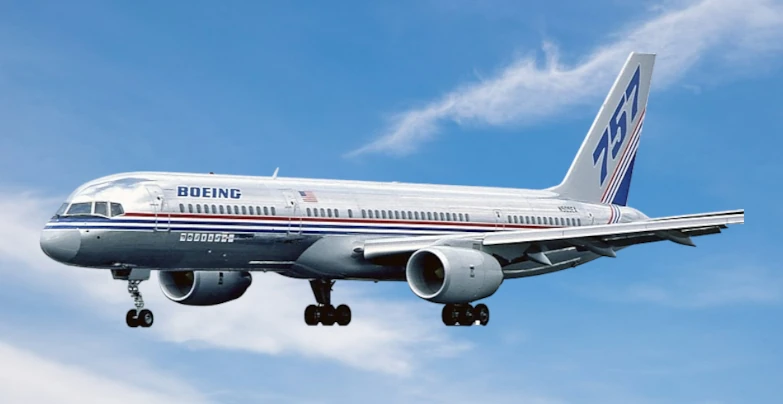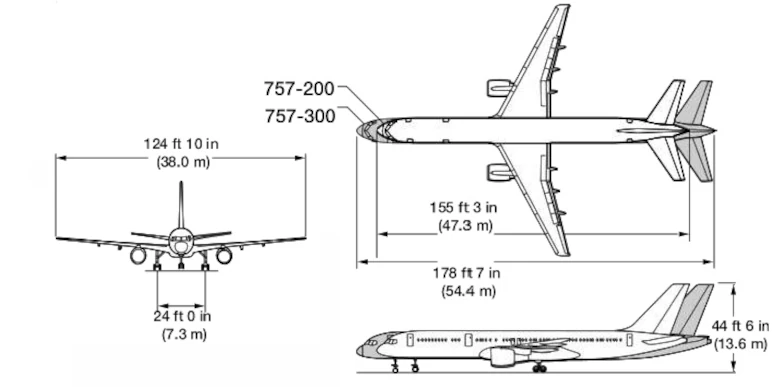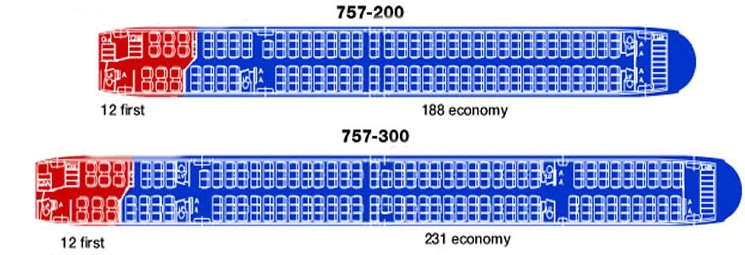
Boeing 757 Details
Introduction to the 757 Plane
The 757 is an iconic fixture in the world of commercial aviation, known for its distinctive blend of efficiency, performance, and adaptability. Since its introduction in the early 1980s, the B757 has carved out a niche for itself as a versatile workhorse, capable of fulfilling a diverse range of operational roles from short-haul domestic flights to intercontinental journeys.
Innovative Design and Engineering
The Boeing 757 is lauded for its advanced design and engineering. It features a narrow-body configuration with a twin-engine setup, which strikes an optimal balance between fuel efficiency and power. The aircraft’s engines, including models like Rolls Royce RB211 and the Pratt & Whitney PW2000 series, are celebrated for their robust performance and reduced environmental footprint due to lower emissions and noise levels.
A key innovation in the 757’s design is its supercritical wing, which reduces aerodynamic drag and improves fuel efficiency at high speeds. This wing design allows the 757 Plane to perform exceptionally well at cruising altitudes, optimizing airspeed and reducing operating costs. The airframe incorporates lightweight materials, which enhance the aircraft’s payload capacity and range without compromising structural integrity.
The 757’s cockpit was ahead of its time, employing glass cockpit technology that streamlined operations and reduced pilot workload. This integration of advanced avionics improved navigation and operational reliability, setting a new standard in the industry for technological integration in flight decks.
Operational Flexibility
One of the Boeing 757’s most significant advantages is its operational flexibility. The aircraft’s ability to take off from shorter runways and operate efficiently in hot and high-altitude conditions has made it a favorite among airlines operating in challenging environments. Moreover, the 757’s range capabilities allow it to serve not just regional but also transatlantic routes, filling a vital gap in the market for medium-range, high-performance aircraft.
History of the 757 Boeing
In the late 1970s, Boeing embarked on a mission to redefine air travel, unveiling plans to develop a groundbreaking fleet of aircraft featuring cutting-edge technology. This ambitious endeavor gave birth to the Model B757, alongside its distinguished counterparts, the 767 and 777.
Initiated by the visionary insights of Eastern Airlines and British Airways, the Boeing 757 project aimed to retire the aging Boeing 727 and usher in a new era of aviation excellence. With pivotal orders from these industry giants, Boeing set out to craft a new generation of airliners, each a testament to innovation and progress. While the 767 and 777 boasted revolutionary fuselage designs, the Model 757 Plane retained the iconic cross-section of its predecessor, the Boeing 727, a nod to its heritage while embracing the future.
As the 757 Boeing took shape, it emerged as a beacon of efficiency and versatility in the skies. With seating configurations accommodating up to 224 passengers at maximum density, this narrow-body aircraft quickly earned its reputation as one of the world’s most fuel-efficient and reliable passenger jets. The introduction of turbofan engines, propelled the Boeing 757 forward, setting new standards for performance and sustainability.
On February 19, 1982, the 757 Plane embarked on its inaugural flight, marking the dawn of a new era in commercial aviation. With FAA certification secured later that year, the aircraft swiftly entered service under the banner of Eastern Air Lines, captivating passengers with its operational economy and unwavering reliability.
Throughout its production cycle, spanning from 1981 to 2004, the Boeing 757 underwent continual enhancements and adaptations to meet the evolving demands of the aviation industry. As the final Boeing 757 rolled off the production line in 2004, its legacy was firmly cemented, marking the culmination of a remarkable chapter in the annals of aircraft manufacturing.
Many airlines have chosen to retrofit their 757s with new technology and interior updates, prolonging the aircraft’s service life and enhancing its operational efficiency.

Boeing 757 Variants
The 757 Boeing, a pivotal model in the history of commercial aviation, has been adapted into several variants to meet diverse operational requirements, making it a flexible choice for airlines worldwide.
The Boeing 757-200 and Boeing 757-300 remain popular with airlines today. Both models offer an optimal combination of capacity, range and economy, making them attractive choices for regional and medium-haul operations. In addition, these models have a reliable reputation and extensive operating experience, which further confirms their popularity among air carriers.
757 Plane Technical Details

Passenger Cabin
| Model | 757-200 | 757-300 |
| Crew | 2 pilots | |
| Passenger Capacity | 200 (standard ), 239 (maximum) | 243 (standard ), 295 (maximum) |
Performance
| Model | 757-200 | 757-300 |
| Range | 7,250 km | 6,295 km |
| Cruise Speed | 854 km/h | |
| Maximum Speed | 918 km/h | |
| Takeoff Length | 2070 m | 2605 m |
| Engines | 2 × Rolls-Royce RB211 or 2 × Pratt & Whitney PW2000 | |
| Engine Thrust (kN) | 2 × 163-193 | |
| Max Fuel Capacity (liters) | 43,490 liters | 43,400 liters |
| Max Altitude (m) | 12,800 m | |
Weight
| Model | 757-200 | 757-300 |
| Empty Operating Weight (kg) | 58,440 | 64,340 |
| Max Takeoff Weight (kg) | 115,660 | 123,830 |
| Max Landing Weight (kg) | 92,250 | 101,600 |
| Max Zero Fuel Weight (kg) | 84,360 | 95,250 |
| Cargo Compartment Volume | 43.3m³ | 61.7m³ |
Dimensions
| Model | 757-200 | 757-300 |
| Length | 47.30 m | 54.40 m |
| Height | 13.60 m | |
| Wingspan | 38.00 m | |
| Wing Area | 185.25 sq.m | |
| Fuselage Width | 3.70 m | |
| Cabin Width | 3.54 m | |
Cabin Features B757
Inside, the Boeing 757 offers a comfortable and accommodating cabin environment. It was designed with passenger experience in focus, featuring upgrades such as more spacious overhead bins, modernized lavatories, and enhanced seating arrangements that offer more legroom and comfort.
The Boeing 757 seat map is flexible, capable of accommodating various seating configurations to meet the specific needs of different airlines and service routes.
Additionally, the 757 has been configured in various service classes, ensuring that it meets the varying levels of comfort and convenience expected by passengers across different market segments.
Service Classes on the 757 Plane
Economy Class: The mainstay of the 757’s cabin, economy class offers practical comfort and efficiency. Seat designs have evolved over the years, with newer slim-line seats providing more legroom and improved ergonomics. In-flight entertainment and connectivity options have also been upgraded to enhance the passenger experience.
Premium Economy: Available on some 757s, this class offers more space, enhanced seat comfort, and additional amenities compared to standard economy.
Business Class: Configured to cater to business travelers, this class offers lie-flat seats on some transatlantic 757 models, along with superior dining options, increased privacy, and premium entertainment systems. Business class provides a more exclusive and comfortable experience for those willing to pay a premium.
First Class: Though not as common on 757s, particularly on newer configurations, some older models featured a first-class. This class may provide wider and more comfortable seats with greater line spacing, possibly with recline adjustment and leg support.






